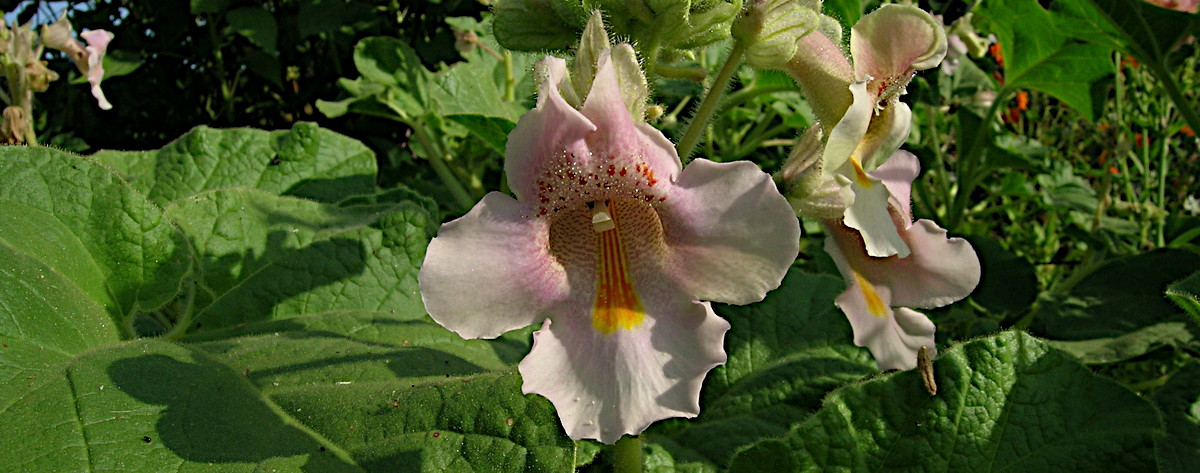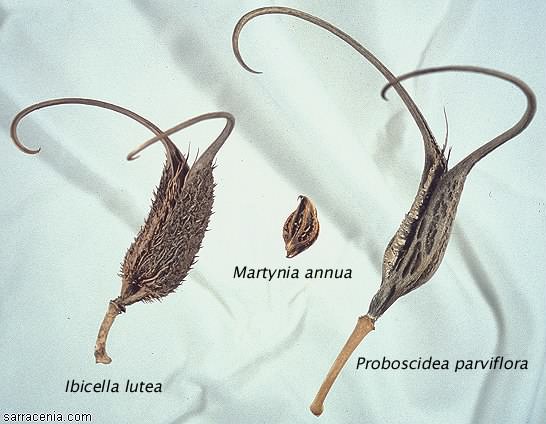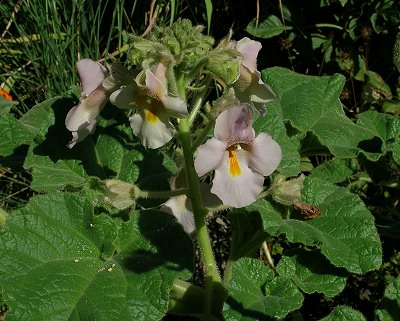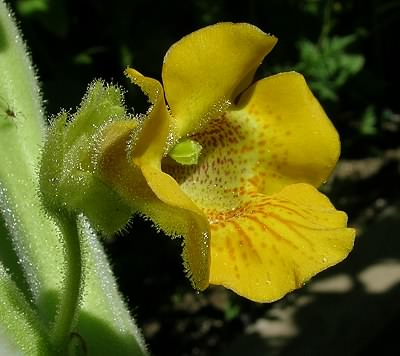
Proboscidea parviflora.
These plants are nasty. The popular name Devil's Claw understates the features of Ibicella lutea, Proboscidea louisianica, and Proboscidea parviflora. They could equally be called Devil's Breath or Devil's Snot. You don't want to grow these plants if you have small children or pets that blunder into your garden plants.
Ibicella and Proboscidea plants get big. If you live in an area that has hot summers, expect the plants to be at least a meter (3 feet) across. They have a rather unpleasant smell—something like rotting gym socks. The smell won't put you off lunch but it does serve as a warning to remind you to keep away. And keep away is something you may want to do. The leaves and stems are covered with a resinous slime that you can't easily wash off. It gets on your clothes. It gets on your hands and arms. It gets on your garden tools. It won't come off. And then there are the seed capsules. Those suckers are evil. They are very sharp. They are designed to snag onto animal feet and hold on until the poor beast dies.

Photo © Barry Rice, sarracenia.com.
Seed pods of Ibicella lutea, Martynia annua, and Proboscidea parviflora. No one has accused Martynia annua of being a carnivore. It just has shady relatives. Note the very spiny pod of Ibicella lutea and rather smooth pod of Proboscidea parviflora.
Proboscidea parviflora and Proboscidea louisianica pods are indistinguishable except certain varieties of Proboscidea parviflora have been selected by native Americans to have longer claws to produce fiber for baskets. Native Americans also ate the seeds.
Each half of the seed capsules has two rows of seeds. The inner row of seeds fall out where the claws split apart. You can see the opening on the Ibicella lutea capsule. These seeds would be scattered as an animal with an attached claw walks around. The outer row of seeds will not fall out and can only be removed by breaking open the capsule and prying them out. These seeds would be fertilized by a carcass or otherwise be spread when the capsule is crushed.
Ibicella lutea, Proboscidea louisianica, and Proboscidea parviflora are not carnivorous and would instead be considered murderous plants. The smell probably deters predators but also attracts insects such as the small flies, gnats, and beetles that accumulate on the leaves. The insects do die. But the plant doesn't produce digestive enzymes and doesn't actively absorb the nutrients. In fact the slime itself probably limits the nutrients the plant could gain from the rotting corpses. The slime is most likely a predator defense although the plants can be ravaged by moth larvae that don't seem to be bothered by the slime and like to hide inside the hollow stems.
So why grow these plants? Because you can. Because you know they can't be that evil (you have been warned!). This is definitely not a house plant. Ibicella and Proboscidea should be planted in a garden or a very large pot. No special soil is required. Regular tap water is fine. Grow the plants like you would any long growing season plant in your area. Take care of it like you would tomato or zucchini. Fertilize it if you dare. The main requirement is full sun and hot weather. The full sun and very warm location are especially important if live you in a location with a short growing season.
Do not ever let these plants or their seeds get out of your direct control. They can become invasive weeds and kill wildlife. The Seed Bank no longer carries seeds of these plants.
— John Brittnacher

Proboscidea louisianica from a safe distance.

Proboscidea louisianica flowers. The red arrow points to the calyx. In this species the calyx consists of 5 sepals fused for half their length. In Ibicella lutea the sepals are not fused.

Ibicella lutea flower.
